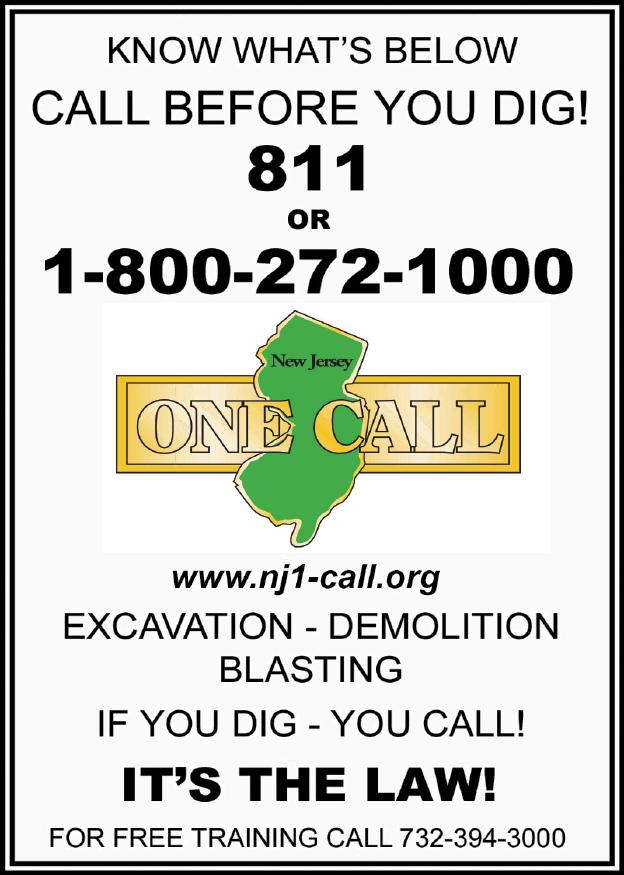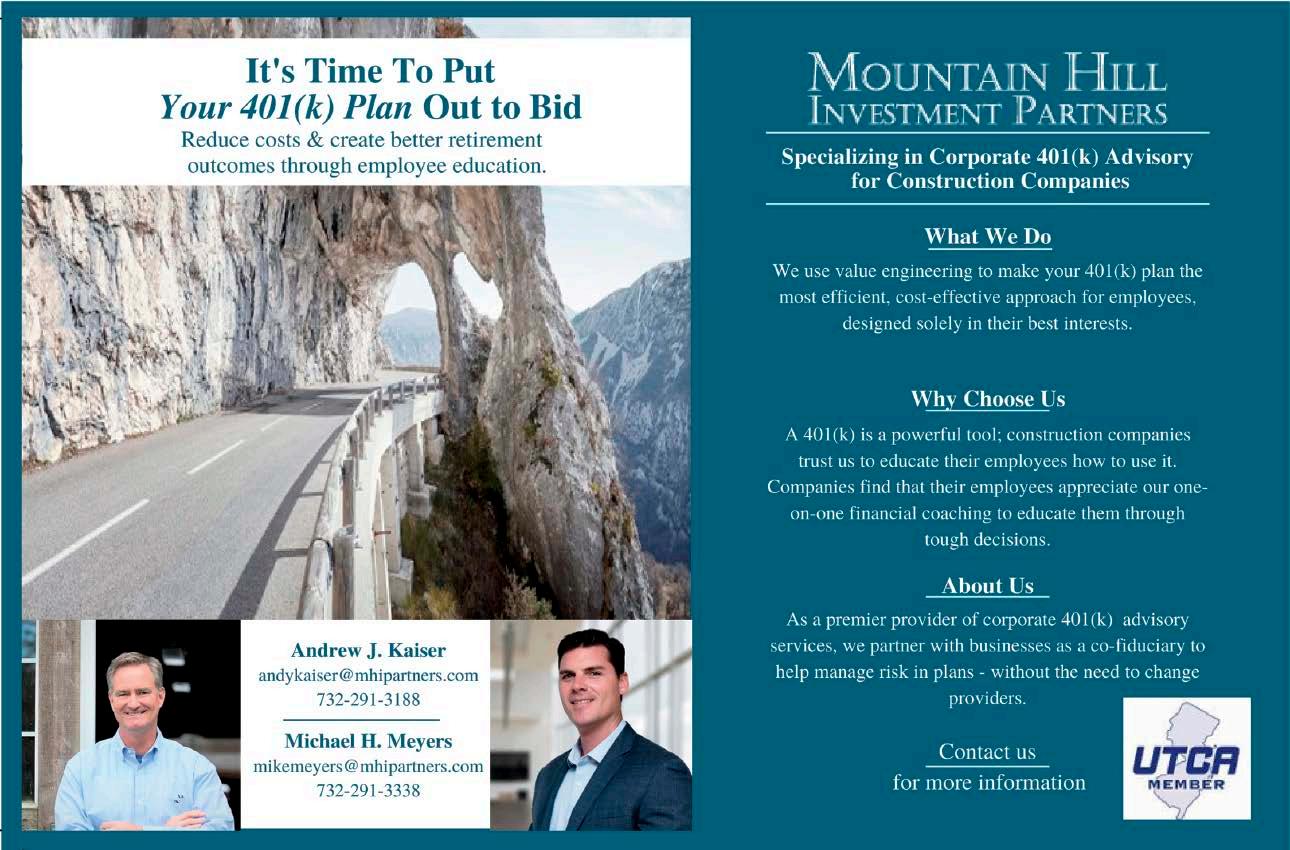
3 minute read
three steps to value engineer your 401(k) plan
by: michael h. meyers, partner, mountain hill investment partners
Like value engineering a construction project to substitute materials and methods with less costly alternatives, (though not at the expense of quality), a 401(K) plan should be value engineered to ensure it’s the most efficient, cost-effective approach for your employees. For example, you might replace cast-in-place concrete with pre-cast concrete to lower cost but achieve an equivalent or even better product. This is a similar practice to replacing an expensive investment option in your plan with a more cost effective one that has provided equivalent or better performance over time.
The six phases of value engineering: information gathering, functional analysis, creativity and innovation, evaluation, development, and presentation can all be applied when analyzing a 401(K) plan. You incorporate this in your projects to achieve a better result, enhance your reputation, and promote new business with your firm; you should be doing the same with the 401(k)-benefit offered to your employees.
Benchmark Your Recordkeeper:
At its most basic, a recordkeeper keeps track of employee funds in a 401(K) plan, think of firms like Fidelity, Empower, Charles Schwab, and Ascensus. According to the 2022 PLANSPONSOR recordkeeping survey, they collectively provide administrative services for over $10 trillion in defined contribution assets with more plans starting every year. This asset growth is happening while the recordkeeping marketplace itself is consolidating; in the past 10 years the number of retirement plan recordkeepers has dropped from about 400 to just over 150.
The Department of Labor emphasizes the practice of benchmarking your recordkeeper; it is meant to create a formalized procedure that plan sponsors can follow to make sure their plans meet current fiduciary requirements, as well as to insure they are in line with current industry trends on pricing and services. Best practices suggest that plan sponsors should formally benchmark their recordkeeper every three to five years, although our experience is that many haven’t been through the process since the start of their plan. This isn’t to suggest that plan sponsors need to change recordkeepers each time; according to the survey mentioned earlier, most plan sponsors (61%) have been with the same one for over eight years. However, it is important and can help identify fees that are excessive of market rates or service that is lacking. Like value engineering, we’re not looking to simply cut costs during this process, we want to evaluate the needs of the plan and compare the current costs to those offered by similar players in the space.
Engage an advisor to vet several different service providers. Let them have the meetings with sales teams and collect pricing, service, and technology information that they can then present to you in full. Following the presentation, select the top two candidates and coordinate a meeting with all parties. This has worked well in my experience; plan sponsors receive a synopsis of all the information from each provider which frees up their time to focus on running the business.
Benchmark Your Fund Line-Up:
As a plan sponsor, you have a fiduciary responsibility to pay only reasonable 401(K) fees so the investment returns of your employees are not reduced needlessly. Fee compression in mutual funds and exchange traded funds has been a trend for years but not all plan sponsors have been fast to act on the changing landscape. We regularly review plans with bloated revenue sharing arrangements full of 12b-1 fees (I call these hidden fees) and other “indirect fees”. Although these fees are required to be disclosed, they are often buried so deeply they’re difficult to find.
The National Bureau of Economic Research issued a paper in December 2022 (“Mutual Fund Revenue Sharing in 401(K) Plans”) and found, unsurprisingly, that “401(k) plans that utilize mutual fund revenue sharing as a method of paying for recordkeeping fees and other administrative services are more expensive on average, and the higher expense ratios are not offset by lower direct fees or by superior performance.” In other words, this type of arrangement was not in the employee’s best interest.
Hold Your Advisor Accountable:
How often do you meet with your 401(K) advisor to discuss the plan? I think the answer for most is: infrequently. You should expect your advisor to review the overall health of the plan on a regular basis and meet with you quarterly to report on various metrics such as: participation rates, employee savings rates and asset allocation. Your advisor should be easily accessible to employees and take the initiative to provide advice in group and individual settings that is tailored to their needs. Great advisors will continually work to drive participant success, lower fiduciary risk, and reduce fees. As a co-fiduciary, the advisor also shares in the responsibility to ensure that the plan is compliant with ERISA regulations. Hold your advisor accountable by setting guidelines for the service you expect of them, and make sure their compensation is fair and transparent.
As we begin a new year, make it a priority to value engineer your 401(k) plan. My firm works as an advisor and co-fiduciary to corporate 401(k) plans, specializing in the construction industry. We work with UTCA firms to enhance their 401(k) offering by vetting service providers, lowering costs, and building employee education programs. We appreciate that each company is unique, and we take the time to understand your needs before creating a customized plan that is suitable, low cost, high value, and ERISA compliant.
Contact me, Mike Meyers, at (732) 291-3338 or mikemeyers@mhipartners.com for more information and to schedule a plan review.
Disclaimer:
Mountain Hill Investment Partners is an SEC Registered Investment Adviser. We have a clearing and custody relationship with Fidelity Brokerage Services LLC, Member NYSE/SIPC.










